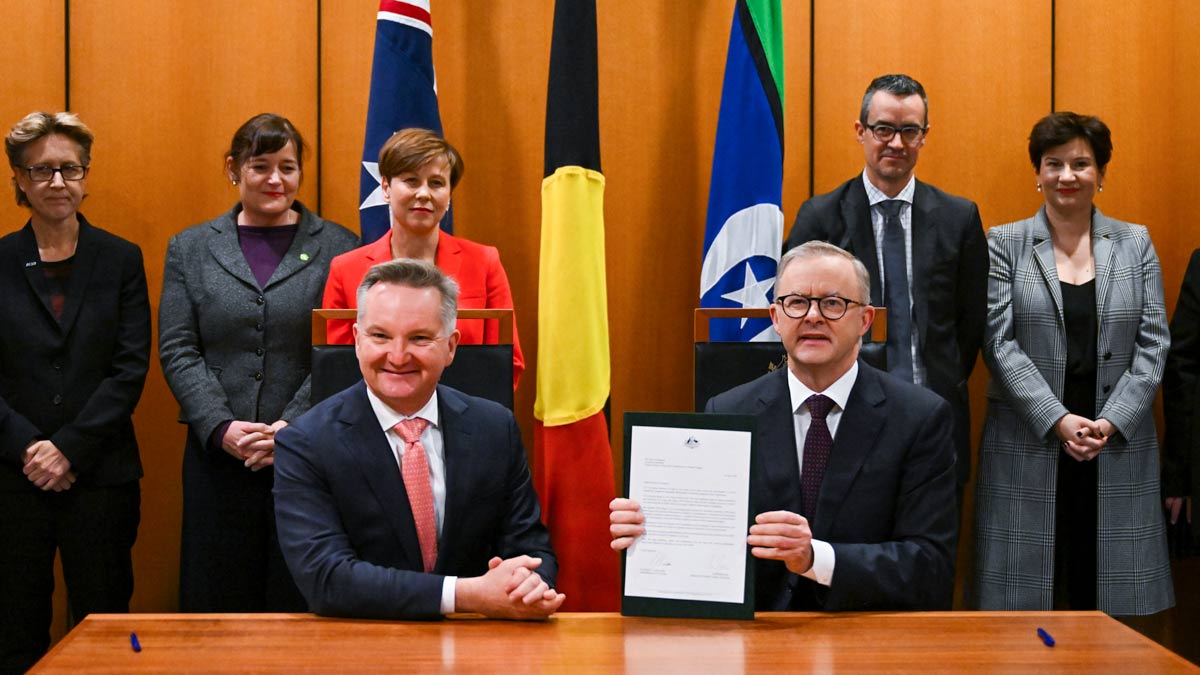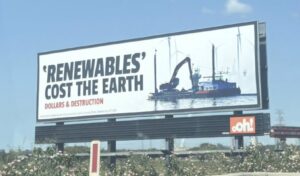When former PM Scott Morrison released his ‘net zero’ plan in late 2021, it was hollow. A bunch of accounting tricks and vague promises. But as a final fuck you to Australians, his department didn’t even bother lying about the last 15%. It was net 94 million tonnes, not net zero. At that point, Morrison was so checked out, they weren’t even trying to hide their all-encompassing nothingness.
This time last year, Morrison lost the federal election to Anthony Albanese and his Labor party. And what Labor have spent their first year doing, in terms of climate policy, has been more than nothing. There have been policies, parliamentary debates, things being passed and terabytes of PDFs.
But it has been as little as they can get away with. My god, have they dedicated real effort to ensuring that every policy and every action is nothing more than a tentative toe in the water, and holy hell do they fight with real passion and intensity against any push to do better.
Over the first year, they’ve laid the groundwork for a bad first term. Their climate targets are designed, from the ground up, to avoid ambition. Their industry and fossil mining policy is designed and approved by the worst emitters, and an outbreak of ‘something-is-better-than-nothing‘ ensured it remained fossil-friendly as it took its final form.
The transport sector’s policies are just about to undergo the same. The power sector’s glory days are passed because the prospect of controlled coal shutdown and new renewable incentives are both unmentionable. And because the government can’t talk about a controlled exit from fossil fuel production, they’re sentencing both the workers and the country to actual catastrophe, no matter what the world does, and no matter the growth of a ‘clean energy superpower’.
They are one third of the way through their term. There are 6.5 years left to 2030. They are the government of one of the world’s most fossil-reliant nations. This is the critical decade – if the curves don’t start bending now – today, and tomorrow – we’re screwed. The ecosystem of solutions for climate change grows every day. Public support never stopped rising, strengthened by the fact that climate action helps ease the impacts of an energy crisis that’s bringing billions in profit to fossil fuels. Labor’s big moment should be now, but they’ve frozen in the spotlight.
Yeah, they’re not Morrison, or Turnbull, or Abbott. They don’t do nothing. But all they’ve done is as little as possible: minimum something.
A target should test you
Remember 2015? PM Tony Abbott ate an onion. The Force Awakens was released. And a guy named Bill Shorten set a net zero target for the year 2050, along with an emissions reduction target of 45% by 2030. That was at the lower end of 40-60%, recommended by the remnants of the independent government climate advisors, the ‘Climate Change Authority’ (CCA).
Fast forward to December 2021, nearly six years later. Opposition leader Anthony Albanese prepares to announce an updated 2030 target. Since 2015, Australia has been ravaged by bushfires, a major IPCC report has been released, and renewable energy has grown cheaper, fast. Here it comes, the fans murmured. The moment we’ve all been waiting for.
The expectant smiles collapsed into frowns. In a document published by consultancy Reputex, Labor showed that plugging all of their existing policies into a model resulted in an emissions reduction of 43% – and, so, that was the target. A weakening by 2%, from the target they had set six full years prior.
The 43% isn’t really a target – it’s more of a projection of their current policy suite. To set a 2030 target this way is to openly reject the concept of ambition – of a target that reflects the real spectrum of possibility in front of you, and the demands of the physical Earth system. It is a declaration: we won’t try harder.
Labor fought like a centrist rottweiler (it’s rabid, but it still watches the West Wing) to ensure that the 43% target was legislated, despite the occasionally murmured admission that legislating it is mostly symbolic. Labor and its various defenders in media and business moaned reproachfully about what they’ve called “the climate wars“; a term they refuse to define. Not a problem, when you realise they define climate peace as the immediate and uncritical, unchallenged passage of all climate policies, no matter how bad or counter-productive.
‘Blocking our insufficient policy we’ve designed to be as weak as possible? You’re delaying climate action!!’
The revisionist bogeyman of the 2009 blocking of the CPRS by the Greens was yelled often, and with real reproach. A weaponised emotional memory, there to ensure anyone holding them to a standard higher than ‘not Morrison’ was sent packing. Labor get criticised for having no fight in them, but that’s not fair. You should see them defending bad climate policy.
Labor insisted in their defence – constantly – that 43% is a “floor, not a ceiling”. I still find this brain-meltingly absurd. The entire point of a target is that it’s a minimum goal, not a maximum limit, or a range. It was offered like it was some extra special promise, when it just described the dictionary definition of target. It spoke to the weird corners they had to go to defend the indefensible.
Plenty of effort has gone into trying to present their weak settings as very brave. In an interesting but problematically forgiving review of the Albanese government’s first year, former Labor staffer Sean Kelly writes that:
“Albanese has a long list [of significant actions], but in particular points to the government’s actions on climate and clean energy, including the way they have changed Australia’s place in the world”
Courtesy of Carbon Brief’s Simon Evans, this chart nicely illustrates that Albanese’s commitment puts Australia behind the UK, Germany, the EU, the US (their target strengthened since this chart was made), Japan, Canada and South Korea. On the target alone, Australia remains a laggard, and that’s before we get to everything else.

Has Albanese actually looked at the world? He’s going to have to, at some point, considering both Bowen and Albanese want to host COP31 in 2026. The idea is that it would be hosted in partnership with Pacific nations, but those same nations are demanding that Australia do far, far better on its climate policies. “Awarding Australia hosting rights to COP21 in anticipation of it changing its ways risks rewarding it for decades of recalcitrance. Instead, Australia must change its ways first”, said the Australia Institute. And holy hell, do they have a long way to go.
Though recent emissions data only cover the first half-year, it’s clear there is no inherent strong and systemic downward trend in emissions. At current levels, net zero will be reached in the early 2100s, along with the 43% target being comfortably missed (it’s worth noting that the Albanese government is using the same tactically-selected data revisions to boost their narrative in emissions data that the Morrison government did, revising fuzzy land-use data but ignoring severely under-reported methane, to ensure data’s always revised downwards).
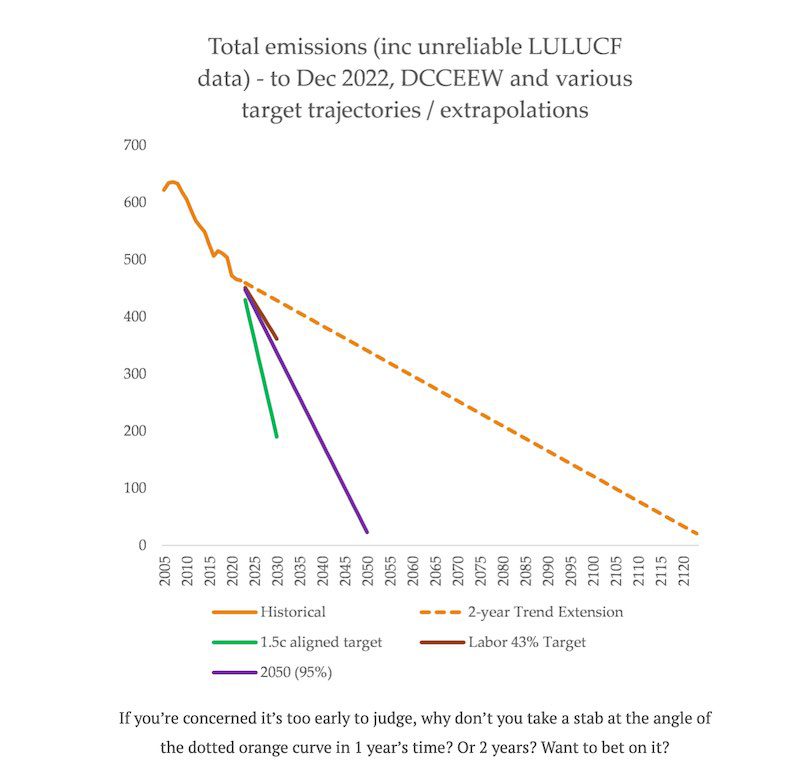
Labor better hope their 2021 modelling was cautiously conservative, because if the policies underperform, even slightly, they’re in trouble. If technologies hit social, cost or legislative roadblocks, even temporary ones, they’re in trouble. And if Labor ends up systematically badly off track for their target, we know for sure they won’t ratchet up their policies in response. Which means they will be in more trouble than they can possibly imagine.
When asked to list Labor’s greatest climate achievements of the past year, legislating the 43% “target” often came first. This, alongside very serious criticism of too much ambition. “I’m a firm believer in under-promising and over-delivering”, PM Albanese told NineFax Journalist David Crowe. This is fundamentally exactly the wrong way to think about climate action, and targets.
The recent history of Australia’s climate projections shows something significant: what we think is possible is something that changes over time. For instance, Australia’s old 2020 renewable target of 41,000GWh was revised downwards out of fears it was too hard to reach. And still, breezily, the original target was exceeded (imagine where we’d be if that target had been strengthened and extended, rather than weakened).
When it comes to climate solutions, the range of possibilities is in a constant state of flux. Stuff that was unthinkably difficult becomes almost boringly feasible in the space of months, now. This state of affairs is incompatible with cowardice, or centrism, or neophobia.
Fun fact: Energy Australia pulled this exact bullshit line exactly ten years ago, arguing there might be “too much” renewable energy.
They were proven so amazingly wrong that it almost feels cruel to bring it up. https://t.co/e5sWPSdS5Nhttps://t.co/PTa6Utw4Dk pic.twitter.com/dEcZ9j31AQ
— Ketan Joshi (@KetanJ0) May 12, 2022
In his profile of Albanese, Sean Kelly counters the centre-right characterisation of Labor, and (cautiously) predicts a slow-burn pathway to deeper, greater action in the near future:
“It is at least possible that the government’s centre will turn out to be what Albanese so often talks about: a patient commitment to long-term government in the pursuit of building a society in which nobody is held back and nobody left behind”
Sure, it’s possible. But we can say with confidence that it’s absurdly unlikely. Between 2015 and 2021, Labor weakened their 2030 target from 45% to 43%, despite an explosion in the potential opportunities for climate action in those years. When the circumstances change again in the next seven years, the Labor government will have performed no adjustments to their 2030 target (with the possible exception of weakening it further, I guess). They are not responsive to circumstance, or the realm of possibility. They hate that realm.
Perhaps Labor held back on ambition purely to get elected, and now they’re in, they’ll let it rip. Except, they’re already preparing for the next election, and the one after that, and thanks to a 2019 loss, they’re still under the obviously wrong impression that climate ambition results in lost elections. No; they’re in a state of perpetual paranoia, and they’ve fallen 100% for the right-wing meme that climate action is unpopular.
It’s worth noting that at some point soon, Labor will need to set a 2035 target. By drawing a straight, linear line out from 2030 to 2035, they’ll probably settle on a 55% target, announced in early 2025 for COP31 and the next election. The fives rhyme, too – a huge bonus. Hashtag Fifty-five by thirty-five. It’ll be absurdly insufficient, but Labor will argue moving any faster would be destructive to the economy. Because it’s a bigger number than 43%, it’ll be breezily and totally uncritically seen as an increase in ambition rather than a continuation of the current mediocrity. And it’ll be green-lit by a ‘Climate Change Authority’ advisory body that has been gutted and replaced with vested interests, who are more than happy to give a tick of approval to climate delay.
Labor legislating the 43% target was seen as a ‘step in the right direction‘. But when Labor takes a step in the right direction, it happens in a way that reveals they never want to take a 2nd, or a 3rd, or a 4th. They fight like demons to avoid setting their ambition any higher. They can’t even perceive their own insufficiency; in their minds the weak commitments are world-leading, history-shattering moments. Accumulated superstitions and fears around being ‘too fast’ on climate will never fade. There will be no more steps in the right direction.
There is too much fundamentally wrong in their approach. They won’t fix themselves; they have to be pushed and pressured into it. This process has already been tested in climate policy and, um, look. I’ve got bad news.
The Safeguard Saga set a grim precedent
In the Hunt / Abbott years, a policy known as the ‘Safeguard Mechanism’ was created. ‘Baseline’ emissions caps are set for the country’s highest polluting industries, but those caps float magically high above actual emissions – and the caps rise, if emissions rise. It was shameless, but it didn’t need to be. It could’ve been a 100 page PDF filled with capybara photos and it would’ve done the same job.
For 7 years, the Safeguard sat collecting dust. High-emitters pointed eagerly at it whenever the threat of regulation was raised. See? We’re already regulated! We’re doing climate action!
At some point, an idea formed – what if the policy could be transformed into something with teeth? What if the caps actually fell, and the ceiling began to ratchet downward on companies that had been letting their emissions free-float unchecked?
It’s a foolish idea. Trying to create good climate policy from something designed, from the ground up, to be fundamentally shit, was always doomed. As I’ve written in RenewEconomy (and in a million tweets), Labor’s new version of the Safeguard Mechanism is unsurprisingly bad. It’s a regulation that fails to regulate. It is more like mandated greenwashing. Yes, sure, companies have to buy offsets if they don’t reduce emissions – but those offset purchases can be used to falsely present climate action in their annual reports. By paying a pittance to fake climate action, these companies benefit from breaching their target.
This is really important. They are not compelled to reduce emissions – they are compelled to buy Australian carbon credits. They can reduce emissions instead, if they’re in the mood. But they don’t ever have to.
It’s packed with loopholes. There is no ratcheting limit on offset. The scheme features ‘intensity’ targets and internal credit systems that will likely incentivise more emissions. It performs the same action-delaying function as the old Safeguard, but instead of just being quietly shit for seven years, modern pressures of climate scrutiny means it has to perform a loud melodramatic interpretive dance of formulas and caveats and calculations and jargon.
At several points, it claims to hold simplicity as a priority.
And then goes onto create absurdly complicated calculations that dance around the demands of the highest emitters. https://t.co/ODpqABDJbC pic.twitter.com/rcr2Zzcv8Z
— Ketan Joshi (@KetanJ0) February 21, 2023
Carbon offsets are the superstructure of this mess. Safeguard will feign success, but it’ll mostly be off the back of carbon offset purchases rather than real reductions. Falsely, and fraudulently, both the fossil fuel industry and the carbon market industry claim that buying an offset where someone has avoided emissions counts as a total neutralisation of releasing greenhouse gas emissions.
I say this a lot, but it bears repeating: this is completely bonkers. Paying for less harm elsewhere doesn’t neutralise the harm you cause. Carbon neutrality is mythical. Offsets are financialised fantasy. Even with zero fraud and 100% integrity, the entire system is based on a logic that would be immediately rejected, were it to appear in any other segment of human society.
Roughly half of the emissions covered here come from coal and gas mining, both industries that would disappear in a puff of logic if they ever stopped believing in their own eternal growth. Coal has plenty of planned mines, but the likely default outcome is slow shrinkage. Gas, on the other hand, has a collection of psychotic carbon bomb projects gaining real steam. These alone will instantly vaporise the over-complicated equations and budgets of this policy.
Being able to use a tiny, tiny fraction of their super-profits from just one year to remove the grinding contradiction of their expansionist fantasies and climate goals? It’s perfection, for them. Woodside, the second largest emitter in Safeguard has already announced they will meet all of their decarbonisation to 2030 using offsets. Amusingly, they released their climate report, in which they faked reductions using offsets purchases (when emissions really rose), right in the midst of the Safeguard debate.
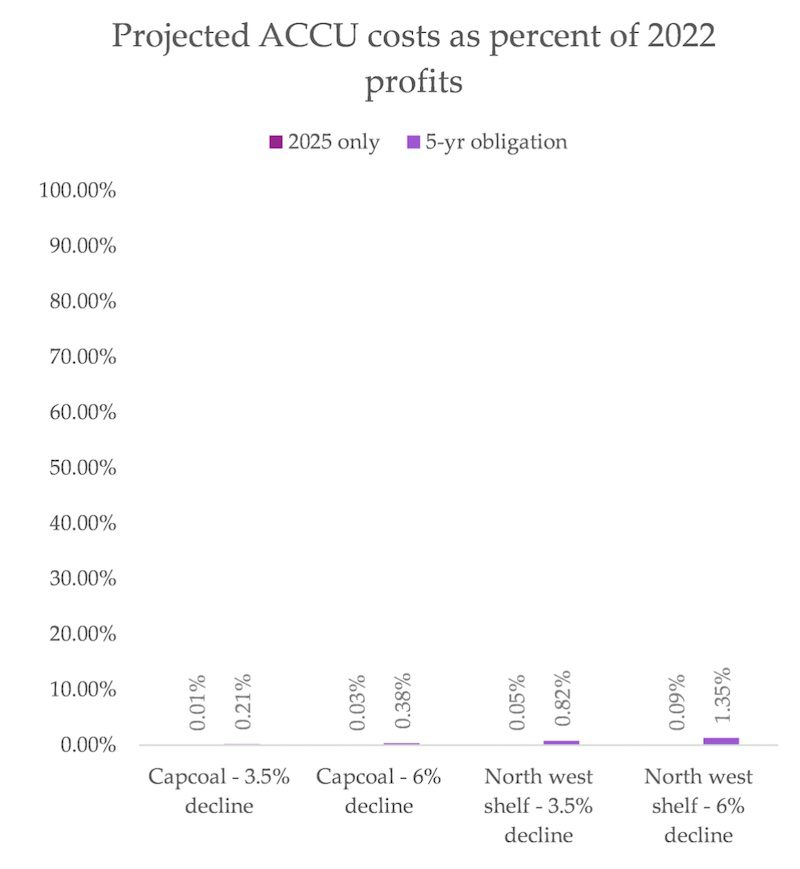
There’s a simple reason this policy is so bad: the reforms were designed by the fossil fuel industry. I thought their footprint was nicely illustrated in the government’s own reforms paper, which I discovered featured fossil industry lobbyists far more than any other group, in quoted responses. Of the non-fossil groups, business lobbyists and consultancies were the next biggest. 6% of quotes are from climate groups.
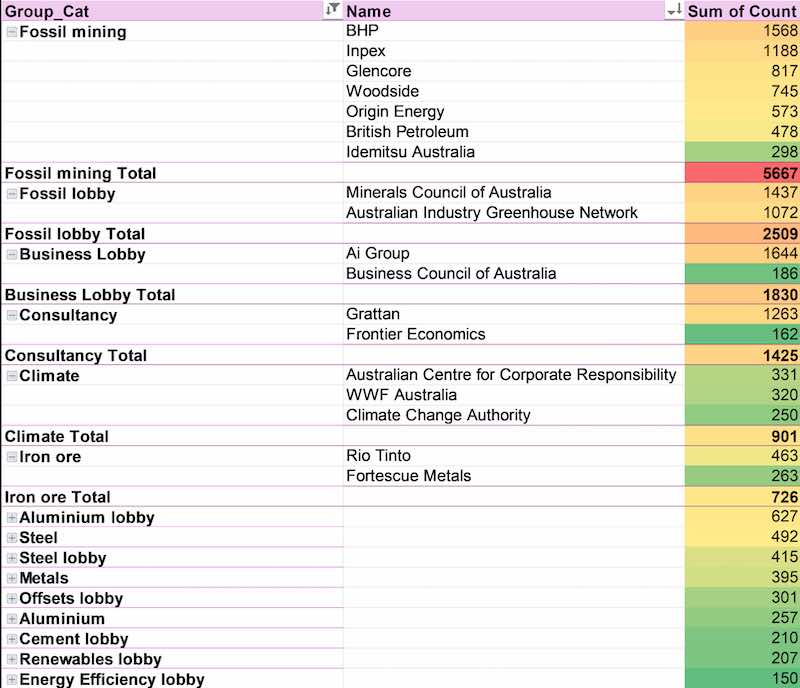

In February 2023, think tank InfluenceMap detailed the timeline of industry demands, and subsequent implementation by the Labor party. These include:
– Capping the price of carbon offsets, and letting taxpayers pay the difference, to ensure greenwashing and fake regulatory compliance don’t become too expensive (a secondary effect is that guaranteed cheap offsets will ensure no company is tempted to actually reduce emissions instead).
– Oil and gas industry associations demanded that high-polluting international traders be allowed a weaker decline rate in their cap. The ceiling drops far slower, for them. When you sell stuff overseas, your emissions count less, somehow.
In October 2021, the Business Council of Australia, which features several major polluters as members, published their ‘Net Zero’ guide. Really, it was more of a list of demands. Their key demand was the creation of a kind of limited-edition carbon offset. When a company sits below whatever its emissions cap is, it gets credited a reward, the size of which depends on how far below the cap you are. If you’re above, you get penalised. These rewards can be traded by companies below to those above, for a market price. The hard physical reality of climate change meets the fuzzy pseudoscience of economics.
By having access not just to actual offsets but the fundamental rhetorical right to *promise to offset*, along with loose definitions of scopes and the ability to design and deploy your own loopholes (LET ME TELL YOU ABOUT INSETTING AT SOME POINT), they’ve caused climate delay.
— Ketan Joshi (@KetanJ0) February 22, 2023
Of course, these special ‘Safeguard credits’ will have their own array of problems. Given that the baselines are based on ‘intensity’, and not absolute emissions, that means a polluter with rising emissions could end up being granted lucrative credits, as long as their ‘intensity’ falls. The concept only works if baselines make sense, but the industry has won an absurd array of complex loopholes in the setting of those baselines, so it’s destined to be an ever-worsening mess.
There are far better ways to tackle industry emissions, without ever needing offsets. Germany just launched a massive new subsidy program called ‘carbon contracts for difference’ that uses cash handouts to companies to compensate them for the increased cost of reducing emissions. That is in itself a reaction to the massive US ‘Inflation Reduction Act‘, again a generous subsidy scheme (notably absurd was the Labor Environment Action Group declaring Safeguard was more significant than the IRA). Though both the US and Germany are failing to tackle fossil extraction like Australia, these policy designs are a million times better than Albo’s worry-free offsetting bacchanal.
Perhaps the biggest demand of the fossil fuel industry is yet to come. Most polluters in the scheme want it opened up to international carbon credits. Somehow even more controversial than Australia’s deeply suspect carbon market, international credits have undergone a near-weekly drumbeat of scandals, revelations, frauds, corruption and deception, this year.
Corporations in Australia like international credits. They’re cheap, because they’re dodgy, so they can pad out the bulk of purchases. Companies will then buy a little smidgen of Australian offsets and feature these most heavily on their comms materials. Telstra, for instance, features 429 words on their Australian offsets on their webpage, and 96 on international. They purchased 11,000 tonnes in Australia, and 2,332,494 from overseas. Those offsets are used for the company’s activities, which include selling fossil gas to homes that should be electrified, instead.
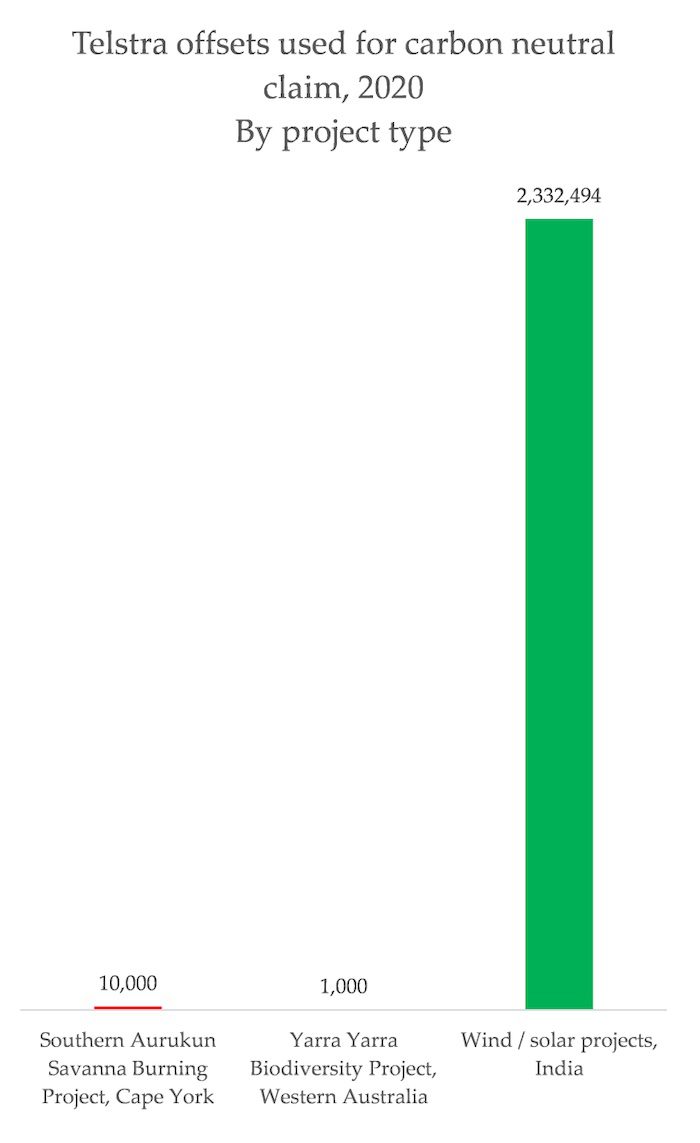
As analyst Michael Mazengarb found, the majority of voluntary offset purchases in Australia come from cheap, dodgy international suppliers. Opening the Safeguard Mechanism up to international credits would update the scheme to be in line with best-practice greenwashing and faked climate action across Australian industry.

Most recently, Chevron was revealed to have purchased most of their carbon offsets from projects that were fraudulent, impinging on human rights, or both. This is what Chevron had to say about Safeguard, a few days ago:
“Chevron was supportive of the Safeguard Mechanism. We do have some concerns around longer-term access to carbon offsets. Our preference would have been for the Safeguard Mechanism to be open to using international offsets along with Australian Carbon Credit Units”
Oh, Chevron. That’s cute. You don’t need to ask, sweetie. The government is going to make it happen for you. “We also welcome the government’s commitment to further explore the use of international credits”, the Business Council of Australia said. You see, they know it’s a matter of time. The government is proud of these relationships.
“Our plan to fix the safeguard mechanism has been endorsed by industry and business—Origin, Rio Tinto, Shell, Woodside, the BCA, the Australian Industry Group, ACCI, the National Farmers Federation and the Minerals Council”, Anthony Albanese proudly proclaimed in parliament, in February this year. This isn’t a new thing; Albanese has seen the endorsement of the worst emitters as a mark of pride for quite some time. Bowen, too.
Labor’s changes were mostly easy adjustments, but the Safeguard Credits bit had to be legislated. That means getting the support of the Greens – who threatened to block the passage of the reforms if the government didn’t push back on coal and gas mining expansion. In most media coverage, discourse and political debate, the majority of the opprobrium was directed at the Greens for the unforgivable act of demanding better policy, rather than at Labor for proposing bad, insufficient policy. Labor knew from the outset the centre of gravity in Australia’s business, media and political institutions sits at climate delay and pro-fossil greenwashing.
Frustratingly, Australia’s left-leaning media institutions and even quite a few climate groups and NGOs felt the best course of action was to critique the details, but to never support the concept of blocking the policy until it was improved. Groups like the ACF and the Climate Council had good, strong demands for reform, but refused to support the Greens blocking bad policy.
The Labor party and their allies in media outlets scandalised the Greens using their balance of power to block bad, greenwashing and counter-productive climate legislation. The underlying assumption was that something was better than nothing, and that blocking that would make the Greens no better than the conservatives. Of course, government mandated greenwashing could easily end up actively worsening emissions than if nothing were passed at all, but this was fundamentally tuned out of the discussion.
It worked. The Greens quietly agreed that they were politically unable to block Safeguard, and they only ended up winning relatively weak changes to the scheme. If a company uses more than 30% offsets, for instance, it has to write a letter explaining itself. I’m sure Woodside is trembling with fear. There is also “a limit on gross emissions, so that from 2024, 5-year rolling average emissions must go down”. Cool. So we’ll have our first data point in 2029. That one is the only emissions “cap” that doesn’t count dodgy offsets in the numbers.
Each amendment is response to failure, rather than a change that prevents failure – and each amendment relies fully on the good sense of the minister at the time, rather than being set down in hard law.
One hell of a return on investment for the fossil fuel industry, who in 2021-22 donated the most they’ve ever donated to the Federal Labor party.

Labor, when threatened with the possibility of actually reducing emissions through a strengthened emissions regulation scheme, fought with bloody cunning to protect the fossil fuel industry, and to protect themselves from having to own and enforce real climate action. The standard has been set: though the Greens hold the balance of power in the senate, they cannot use that power to beat shitty climate policy into shape.
Media institutions and even some climate groups have helped that along. A party that will only act on climate change when bullied, forced and pressured into doing so has demonstrated that it can stand up to being forced into taking real climate action.
This is bad, because in the transport sector, there remains quite a lot left to lose.
Moving nowhere
Cars, trucks, planes, buses, trains. They’re a big chunk of Australia’s climate problem. Things were bad before the pandemic, and they’re bad after the pandemic. The latest projections suggest transport will take the lead as the highest emissions sector once the electricity sector dips below it in 2028.
Those projections, for the first time, revised projected transport emissions in a worse direction, compared to the previous year. Ditto for projected growth of EVs. Labor’s target of 93 MTCO2-e of emissions in transport for 2030 is looking hard to reach without strong new policy.
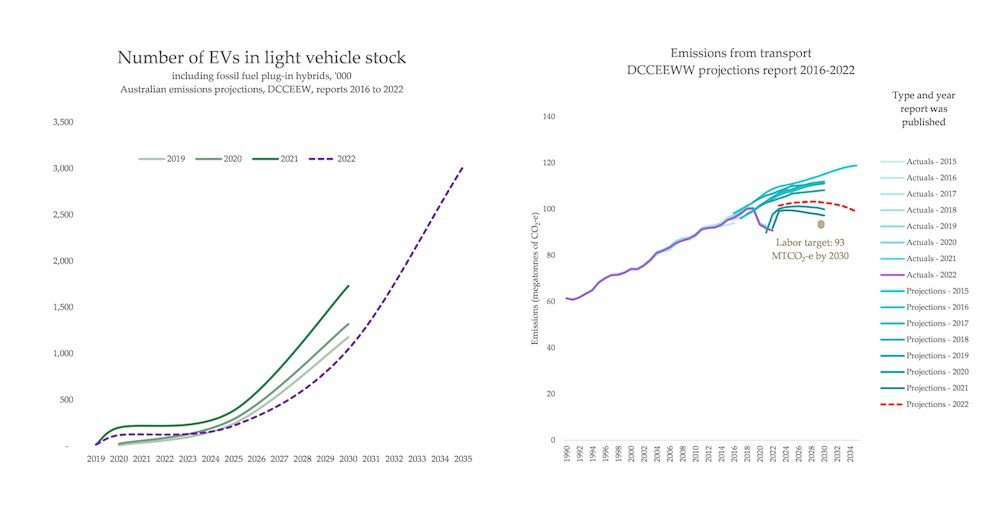
In what should have been good news, the government announced it is planning to introduce a fuel efficiency standard in the near future. The worse the climate impacts, the greater the penalty. It’s simple and effective, and should incentivise more EVs.
The two key problems: that policy is insufficient even if it works well, and it may not work well if it’s compromised by fossil industry lobbying. Despite these standards having been in place in other countries for many, many years now, there will be months, and months of further consultation before Labor make any final decisions about where the policy lands. That makes the ‘compromised’ possibility worryingly likely.
Just like Safeguard, the ‘Federal Chamber of Automotive Industries’ (FCAI), lobbyists for fossil car sellers in Australia, are pushing weak and ineffective policies as a way to simulate concern about climate action while their members continue to worsen climate change. Labor have all but laid out the welcome mat by creating such a wide stretch of time for them to lobby hard to get their way, and it seems likely the FCAI will be at least partially successful in their campaign.
Recently, InfluenceMap analysed FCAI’s playbook here. The overlaps with the fossil industry’s tactics are remarkable.
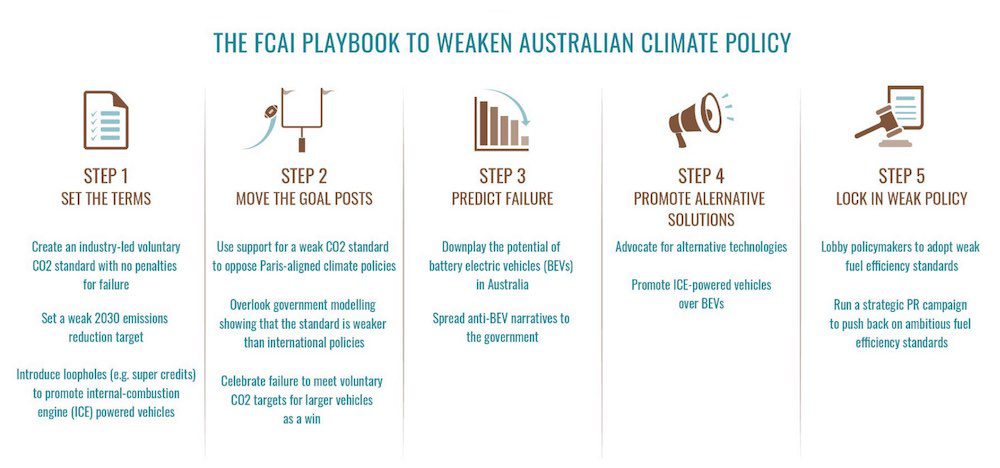
The researchers draw on more than 500 pages of documents revealed through freedom of information laws. They reveal that FCAI have been pushing for the use of – you guessed it – dodgy credits that reward insufficient actions and that will probably end up strongly discouraging any real actions to reduce emissions. “Carry-forward” credits mean companies selling lower-emissions cars sell credits to high polluters. Fundamentally, it’s the same market-mechanism philosophy that allows polluters to continue polluting as we saw with the Safeguard Mechanism. Also, plenty of noise about hydrogen and synthetic fuels; both unlikely to work in real life, but likely to work in delaying climate policies.
There’s a good chance that the car industry’s lobbying could also end up accelerating an already-worsening trend towards bigger, more dangerous cars. Part of the reason cars in America and around the world have been ballooning in size – causing death and destruction on roads – is the result of industry lobbying around fuel efficiency standards, as shown in this great thread by Michael Thomas:
The short answer is that auto lobbyists happened.
At the last minute, auto lobbyists convinced Congress to make a subtle change to the bill’s text.
They got the fuel efficiency standards for trucks to be set separately from cars.
— Michael Thomas (@curious_founder) June 2, 2023
It is far more profitable for a car maker to sell an obscenely over-sized car than a reasonably sized one. As the 2022 projections showed, even though there are some sales of electric vehicles in Australia already, the emissions reductions from those are being completely cancelled out by increasing sizes and higher emissions from fossil fuel cars – which means EVs won’t lead to any noticeable emissions reductions trend until at least 2025, if not later.
Car website Drive breathlessly reports the ever-worsening boom in the sales of massive American road tanks, designed to maximise threat to pedestrians, cyclists and smaller cars. Labor need to design a fuel standard that understands and fights this – if they don’t, any climate progress will just get run down by a Ford F-150.
Perhaps most important is the fact that even with aggressive incentives to get people to buy an EV for their next car, there are still many years between old and new cars for most people. In Norway, where I live, the impact of our world-leading EV policy has only just now begun to change oil consumption and transport emissions – after a decade of gradual change in new sales. Though we’re nearly at 100% of new sales being non-fossil, only about 20% of cars and kilometres travelled are electric. This comes as a revelation to many, because the ‘new sales’ metric gets the most attention.
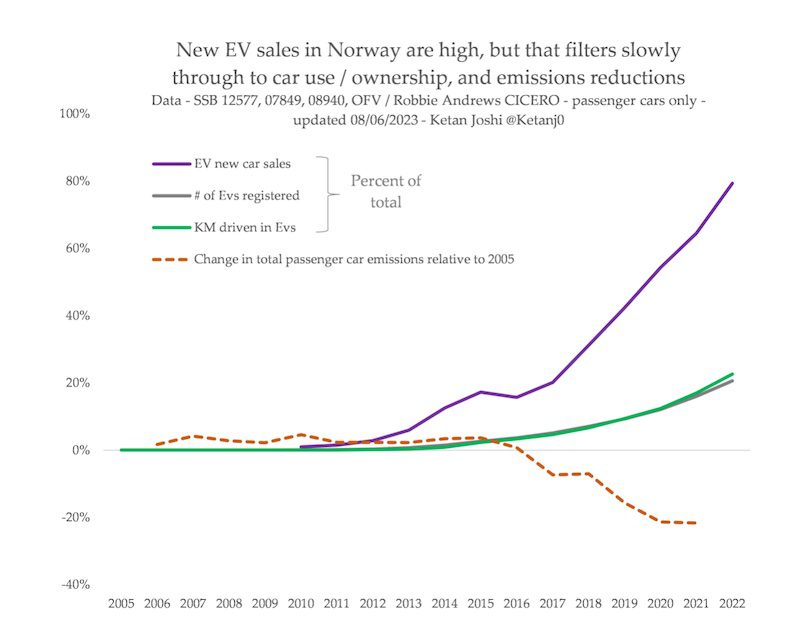
And because our policy was so narrowly focused on consumer purchases, emissions from light and heavy duty vehicles (trucks) have risen in the meantime, countering the reduction from passenger cars and resulting in a stagnating trend in total road transport emissions:

An EV-only transport policy (even a perfect one) means an eventually-big but very slow reduction in emissions. If you didn’t start in the noughties like Norway did, transport policy needs to do much more, such as shifting people away from cars and towards public and active transport (that has the benefit of reducing mineral requirements for car batteries, too).
This, on top of supply chain issues, fluctuating battery prices and global under-supply means the combination of too-little-policy and industry-fuckery of what little there is will have either no effect on total transport emissions before 1990, or only a very small effect.
If nothing changes, Labor will put forward a policy in the ongoing spirit of ‘minimum something’. “This is urgent, which means you should quickly pass badly insufficient policy”, will be the strained logic. When there’s pushback, they’ll say: “If the Greens block this policy, it’ll be just as bad as when they voted against the CPRS”. Someone in a centre-left media outlet will shake their head sadly at the possibility of the Greens voting with the Coalition, despite Labor constantly voting with the Coalition. And eventually, Labor will chalk up the passing of their weak fuel standard as a massive win, and a mark of pride.
If nothing changes, that is. All of this could be mitigated if Labor choose to run with a decent policy from the outset, or if they’re strongly held to account when they don’t. That includes blocking policy designed to greenwash and delay climate action. That includes climate groups coming out just as hard against Labor doing climate delay as they would have against the Liberals doing climate delay.
The situation is dire. And for the one sector where I thought things might be in the bag, I was wrong.
Kill coal and energise clean
In 2010, I took my first real job – a data jockey at a wind farm control centre in Sydney. I never would’ve got that job had it not been for Labor’s ‘renewable energy target‘ (RET), which drove massive expansion in renewable energy for a decade. I certainly wasn’t alone in having my entire career established off the back of a successful, strong and genuinely ambitious Labor climate policy.
As I mentioned earlier, the RET over-performed. It had its doubters, but holy hell did it work, when it was operational and the target was rising. In 2020, the target was exceeded, which meant no more incentivised growth through the scheme.
In 2022, 35% of Australia’s National Electricity Market (NEM) came from clean power. Labor is targeting 82% by 2030, primarily through a policy to ease the construction of new transmission lines. But as I have said before, that is probably insufficient.
The ‘free market’ isn’t going to shut down coal-fired power stations. Yes, renewables are cheaper now, but even that has hit temporary speedhumps (regardless, when Labor established a strong RET policy in 2009, renewables were very far from cheap). And the view of business people and executives in the energy industry as ultra-rational actors is silly. Economic principles are regularly superseded by personal foibles, emotions and ideology. These people are happy to lose money, for instance, if they feel like it fucks the greenies.
Why don’t you ever hear about the RET? It’s baffling. Labor has memory-holed what is very comfortably its single most successful and impactful climate policy. There’s a decent chance that it worked far too well, irritating fossil fuel industries in the mid-2010s, and that freaked Labor out permanently. Whatever the reason, they need to get over it.
Why not formalise the 82% target as a real renewable energy target? The scheme is absurdly popular, and a greenwashing-free (um, mostly) legislative structure already exists. Every sign is pointing to renewable energy in Australia needing immediate, strong government intervention. The growth rate of clean energy is far too slow to hit the 82%:
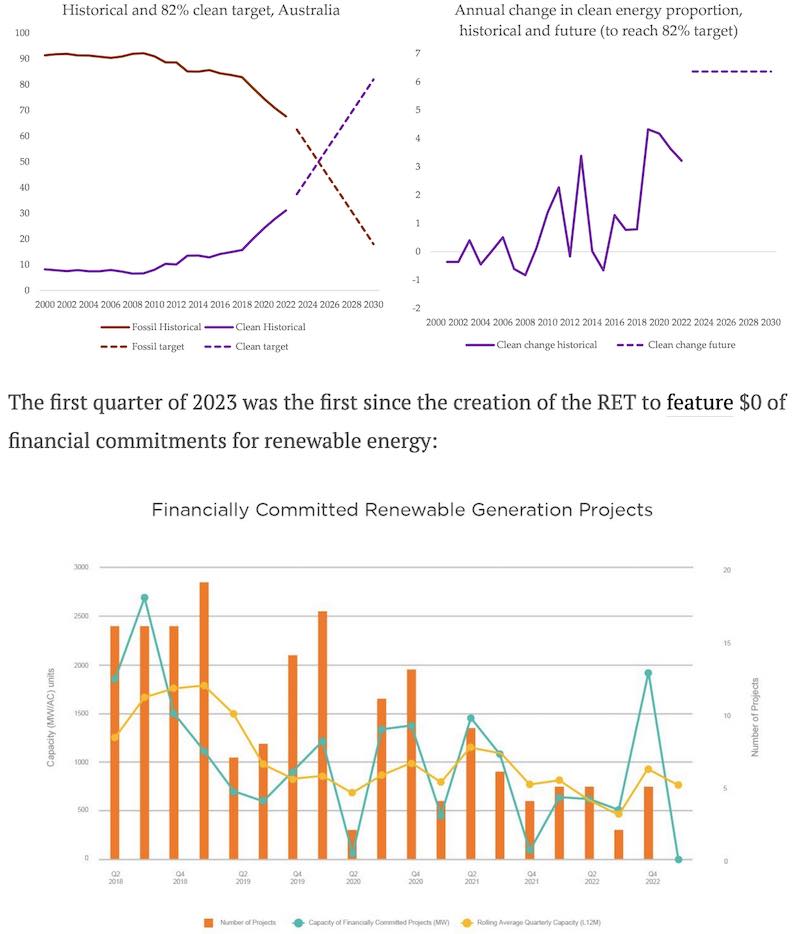
And just to illustrate the perverse priorities here, this drop in renewable energy projects is occuring in the context of an explosion in new carbon offsetting projects, with ever-worsening quality, and based on absurd schemes.
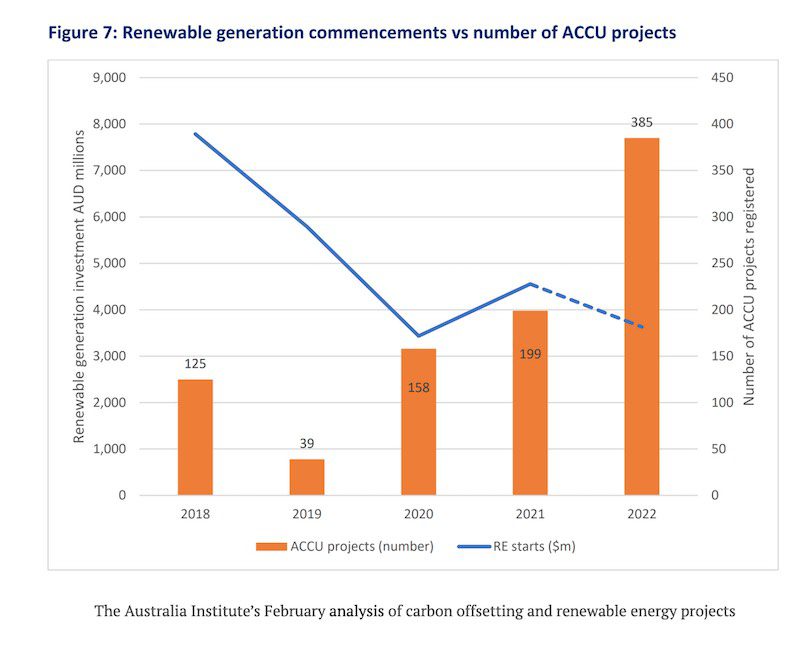
There are also growing signs that the required roll-out of large-scale new transmission lines is due to rub up against community friction. So many of the same issues that plagued early wind roll-out are re-emerging in similar forms, particularly people in rural communities feeling railroaded and excluded from major decisions. Groups like the Renewable Energy Alliance are trying to find ways through this growing morass. And Labor’s ‘rewiring the nation’ plan should help inject some much-needed momentum, here, with a transmission-focused body that’ll handle investment and work on community issues.
Worryingly, there are already signs that the slow-down in clean energy investment is providing cover for operators of the most polluting coal plants to cancel their commitments to closure dates earlier than ‘natural’ end of life. The closure of Origin Energy’s Eraring coal plant, for instance, was brought forward from 2030 to 2025 – cutting Australia’s total emissions by more than 2% for five years.
Except, Origin CEO Frank Calabria hinted at walking that back. Amazingly, the new Labor government in NSW is considering buying the plant purely to keep it running past 2025 – something Origin’s likely new owner Brookfield had to actively push back against. “The issue here with Eraring is that we need to make sure that the lights stay on in NSW”, said new Labor Energy Minister for NSW, Penny Sharpe. Then help accelerate new renewable energy.
Both the state and federal governments are struggling to accept responsibility and show leadership in laying out a timeline for coal’s shutdown. And Federal Labor is failing to canvass new options to accelerate renewable investment, despite all the worrying signs. A new, legislated clean energy target mechanism should be a no-brainer. But the maximum they will do is minimum something.
I think this one is maybe the hardest to take. I watched the success of the RET in real-time, more close-up than most. It wasn’t easy – we had to fight for it, both to keep it and to protect it from being weakened too badly. But it fundamentally changed Australia’s power sector for the better. What’s the reason that same spirit isn’t being summoned here? None that I can see, beyond a passionate desire to avoid meaningful actions.
There is a weird amount of time, effort and cash poured into the problematic vision of turning Australia into a ‘clean energy superpower’ – something that’ll require several times greater growth of renewables than we already have. Why is Labor leaning into this vision of a ‘clean superpower’, when their own policies are still insufficient to even reach the domestic clean power target?
I have a theory.
The Dual Superpower
Australia exports a lot of fossil fuels. The emissions from those exported fuels, when they’re burned, are more than twice Australia’s domestic emissions. Selling the cause of climate change disasters is also a very lucrative thing to do.
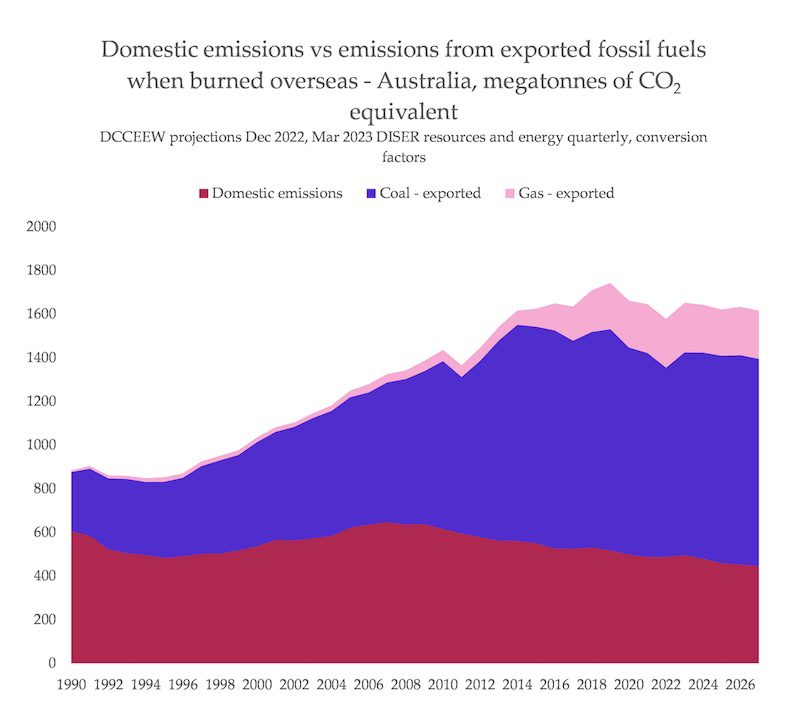
After a year of disgustingly overblown profits thanks to a crippling fossil fuel price crisis, there are a lot of very rich people who want this to continue as long as possible. This is why the architects of the Safeguard Mechanism puts so much effort into greenwashing the emissions associated with the act of digging up these fuels – by focusing on domestic emissions from production, attention is shifted away from the bulk of the impact, which is the consequence of their burning overseas.
And this is why Labor feels no desire to change the planning process to add friction to proposals for growth in coal and gas mining. Environment Minister Tanya Plibersek has approved several already, while rejecting a few that were destined for doom anyway. There is a non-interventionist approach. Exports will rise or fall only as demanded by those purchasing Australia’s dangerous climate products.
This is where there is good reason for hope; due to the number of experienced, dedicated and passionate activists fighting against new fossil fuel projects. The ‘Living Wonders’ project is a group of cases brought against the Australian government, with the intent of challenging these approvals. Environment Council of Central Queensland and Environmental Justice Australia lead the collective.
I think there’s a good chance these folks will be successful, even if that’s just breaking down the walls and opening up the space for more litigation. Labor don’t really want this to be a central issue, so anything that spurs conversation will be a positive.
Labor have instead leaned heavily into a narrative kicked off by former Labor government advisor Ross Garnaut. This presents decarbonisation as a project to preserve Australia’s wealth, power and material excess by exporting massive volumes of clean energy (in the form of hydrogen, or through power cables), alongside a big increase in transition minerals such as copper and lithium.
It works as a way to talk about the future of energy exports without talking about the compulsory dissipation of coal and gas mining companies. It deletes any concern that may be had about Australia simply losing out, in a world that’s ditched fossil fuels. It means not having to consider the fact that GDP growth is a terrible way to measure the wellbeing and happiness of Australians, or its worth as a country. Why is sending vast volumes of energy overseas a compulsory factor in Australia’s existence? Why isn’t anyone asking about the basic assumptions being made?
Most importantly, hydrogen can be produced using clean electricity, or using fossil fuels like coal and methane. The fossil fuel industry has its own fantasies about switching to using carbon capture and storage paired with hydrogen production and preserving its own wealth in that way.
It’s a comforting narrative, but the involvement of the fossil fuel industry suggests that the real plan is to become a ‘dual superpower’, where the fossil fuel industry declines extremely slowly, able to funnel at least some of their energy into greenwashed hydrogen and CCS projects to make that decline even slower.
Labor have done something good here. The “Net Zero Authority” may, if things go right, end up serving as a powerful just transition body, there to ensure communities hit hard by a drop in demand for fossil fuels are protected by the shocks that business and government should’ve begun preparing for more than a decade ago. But what purpose will it serve, if Australia’s fossil fuel industries grow over the next decade, instead of shrinking?
Under the current policy settings, and in a world that fails to tackle climate change, the most likely outcome is a very slow decline in fossil fuel exports, if not a slight rise. This is the future the Labor party is planning for. The ‘net zero’ scenario is fundamentally unmentionable. To mention it would be to admit that it’s possible coal and gas mining companies could face a sudden extinction.
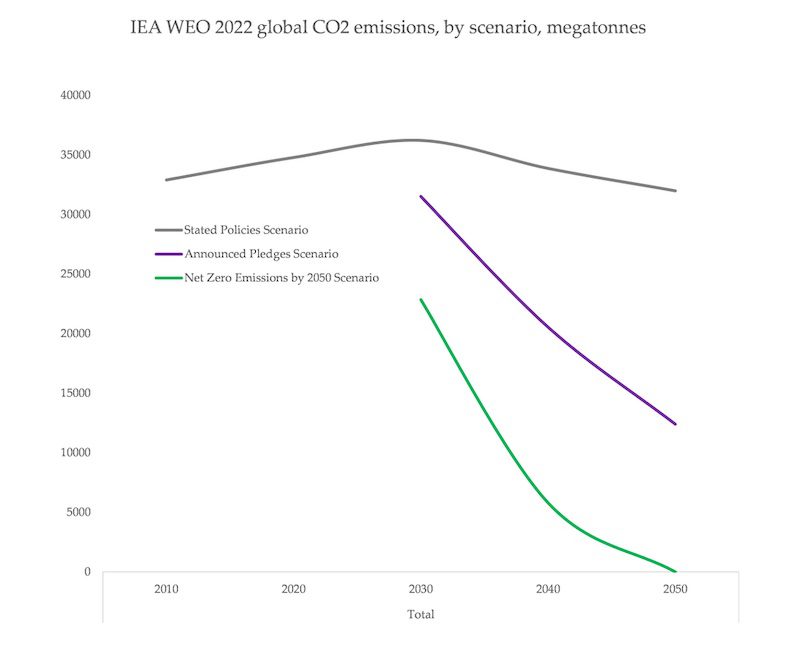
If global climate action accelerates, the demand for Australia’s coal and gas will plummet. Planned mines will vanish, and existing mine operators will panic. Coal and gas companies will demand and win massive government protections, buyouts and bailouts. The remediation of abandoned mines will be paid by the taxpayers. The fossil fuel industry will soak up ludicrous amounts of cash and resources from society, away from those who need them. Chances are that any clean export industry will not have grown large enough to fully replace the fossil export industry, in energy, dollars, or jobs. The ‘Net Zero Authority’ will be at the centre of a national storm.
All of these things will happen if Labor continues on their current trajectory: total denial of the possibility of global climate action.
If Australia’s fossil export industries limp on, that means global emissions are on a catastrophic trajectory, and that means a raft of major new disasters and threats. If they suffer a rapid collapse, that means fewer climate disasters, but an industrial shitstorm domestically.
Chaos is coming; we’re just yet to find out what flavour. A government that is incapable of acknowledging the reality of climate change is guaranteed to screw up the responsibility of this moment. A careful, managed phase-out of the sale of fossil fuels is the only way forward, but Labor seems to be creating a situation where they’re simply adding new clean industries to unchecked dirty ones.
Like their targets, like Safeguard, like transport and power, their bad habit of defaulting to doing as close to nothing as they can get away with on climate has terrible, real physical consequences. There is a human cost, and in the realm of energy exports, it will be high.
Conclusion
I don’t doubt that my criticisms will be dismissed as naive idealism. Albanese has always presented his climate policies as sober, pragmatic and realistic.
But as we have seen, the definition of what is ‘feasible’ does not get set by activists, or experts. It gets set by those with deep vested interests. The fossil fuel industry, and the industries that float around them. They shrunk the realm of possibility to the width of a micron, and the party bought it wholesale. That means Labor can smugly attest to being sensible, when they propose doing nearly nothing about the worst threat we’ll ever face.
In a (long) essay for Vox all the way back in 2015, climate writer David Roberts described the political landscape in the US, and I think at a high level, it applies to Australia, too.
“The right-wing base has a coherent position on climate change: It’s a hoax, so we shouldn’t do anything about it. The left-wing base has a coherent position: It’s happening, so we should do something about it. The “centrist” position, shared by conservative Democrats and the few remaining moderate Republicans, is that it’s happening but we shouldn’t do anything about it. That’s not centrist in any meaningful ideological sense; instead, like most areas of overlap between the parties, it is corporatist”
Labor have often taunted the Coalition for ‘climate denial’, but what does it mean that Labor both accepts the science of climate change, while fighting off real climate policy with a sword and shield?
Energy Minister Chris Bowen cites the short stretch of time between now and 2030, as a reason we need to ‘get moving’ and pass Labor’s policies. But surely the fact that 2030 is coming up quick should mean Labor proposes ambitious, strong, fast-acting policies right now. Surely they should be proposing strong policy from the outset, rather than the ‘pass first, fix later’ attitude. Bowen frequently cites the 1.5C target in interviews, despite the party’s own targets and policies aligned with 2 to 3 degrees of planetary warming.
They can’t mumble their way through it forever. Climate impacts have their own terrible cycles. The chances of a dry, hot summer this year and next are very high. The consequences of unchecked burning of fossil fuels have a habit of sneaking up on governments smirking because they used their political cleverness to defuse scrutiny.
Just ask Scott Morrison, sipping a cool, fizzy cocktail on a beach in Hawaii, while catastrophic bushfires tear through the country he is Prime Minister of, in December 2019.
The next two years of the Albanese government are in bad shape. If nothing changes, Australia will see emissions in electricity, transport and industry stagnate, or fall far too slowly to achieve Labor’s target, let alone any real ambition.
As the 2023 IPCC AR6 Synthesis report reminded us, it remains fundamentally the case that the the harms we suffer in the future depend on the choices we make today. Labor deciding to go weak on their climate policies is a choice.

Yes, I have detailed many instances of others trying to force Labor to do better and failing. But there are still signs of possibility, as the Greens showed through the establishment of a major electrification program for households.
Having jumped around different corners of climate activism, one through-line stands out. There is something you need in your heart, to be healthily engaged in tackling this problem. I think about all the people who I value and love the most in this movement, and they each have a blend of red-hot passion mixed with an intense love and camaraderie for those working the same problem. For the most part, that collaborative mindset exists across an absurd and unprecedented blend of professions and lifestyles and actions, from protesters spray-painting jet planes to workers climbing wind turbines, to wonks working on spreadsheets. It’s tense, but somehow it works.
What we all know is that prying fossil fuels from the central position they hold for our species is completely possible. It’s already underway, really. We just need to accelerate it, but that acceleration is being challenged.
What is in the hearts of politicians in the Labor government?
Genuine joy moves across their faces when they’ve won a political spat, or defended their indefensible climate policies. At all other times, it’s boredom, maybe sometimes a strained reflection of internal conflict, or just a muted blankness as they retreat into their mind palace. What is in their hearts, that they could fight for election and squander their chance?
Every choice matters, and Labor choosing to take the ‘minimum something’ road will have real, physical consequences. They have been handed an opportunity to establish themselves as the government of the critical decade, and they intend not to take it. It isn’t in their hearts.

